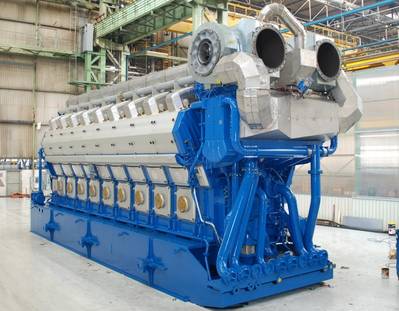Wärtsilä's Gas Engine Technology Enhanced
Wärtsilä has now sold more than 2000 of its gas fuelled engines, which together have accumulated more than 7 million operational running hours in both land-based and marine applications.
These milestone achievements emphasise the global position that Wärtsilä has achieved in gas and dual-fuel (DF) engine technology.
"Wärtsilä's gas and dual-fuel engine technology can be used in all vessel types, and installed both in newbuilds and as conversion projects in existing ships. With fuel costs and environmental compliance being the key issues currently facing owners and operators throughout the marine sector, the use of gas as fuel makes a lot of sense. Wärtsilä has been involved in a number of feasibility studies to evaluate the total cost of ownership using gas as a fuel alternative. LNG has consistently been shown to be a viable and attractive alternative to marine diesel and low sulphur fuel oils. These milestone achievements in the number of gas and DF engines sold, and the running hours accumulated, provide even more evidence of this viability," says Alexandre Eykerman, Sales Director, Wärtsilä Ship Power.
Wärtsilä began development work with dual-fuel gas engines in 1987, the first concept being the gas-diesel (GD) engine with high-pressure gas injection. This was followed by the second generation of gas engines in the early 1990s, when the company introduced spark-ignited (SG) pure gas engines utilizing low pressure gas. The real breakthrough, however, came when the dual-fuel (DF) engine was introduced by Wärtsilä in 1995. This third generation of gas engine development resulted in the ability to combine fuel flexibility and efficiency with environmental performance.
The DF technology enables the engine to be operated on either natural gas, light fuel oil (LFO), or heavy fuel oil (HFO). Switching between fuels can take place seamlessly during operation, without loss of power or speed. The engine is designed to have the same output regardless of the fuel used.
2-stroke dual-fuel engine development
In late 2010, Wärtsilä initiated a major project to extend its leadership in dual-fuel engines by adapting its low pressure gas engine technology for use in its low-speed engine portfolio. Subsequently, a new test engine, the 'RTX-5',based on a commercially available 6-cylinder RT-flex50 engine, was installed in the Trieste engine laboratory in Italy in March 2011. The resulting tests with the low pressure 2-stroke dual-fuel engine have successfully demonstrated that, for the first time ever, low-speed engine performance can fully comply with the IMO Tier III nitrogen oxide (NOx) limits when operating on gas.
Wärtsilä's low pressure 2-stroke gas engine is scheduled for release during 2013 and will be available for commercial use in 2014. It will be incorporated into the full portfolio of engine types during 2015 / 2016 to provide customers with a solution of their choice.
Cost-effective compliance
Natural gas is the alternative fuel that offers the greatest potential for complying cost-effectively with the International Maritime Organisation's (IMO) upcoming environmental regulations. In particular, dual-fuel engine installations offer the flexibility to use clean natural gas when operating in Emission Control Areas (ECAs), and conventional fuels when not. While running on gas, Wärtsilä's dual-fuel low pressure engines require no additional equipment, such as exhaust gas after treatment, to meet the IMOs Tier III NOx regulations.
Since the first Wärtsilä 50DF engines were fitted onboard LNG carriers some ten years ago, approximately 65 per cent of all new LNG carriers have been fitted with Wärtsilä dual-fuel engines. At the beginning of this year, a key milestone was reached when the Wärtsilä 50DF engine was supplied to the 100th LNG Carrier vessel. In addition to this success, Wärtsilä gas and dual-fuel engines are becoming the propulsion choice throughout all segments of the shipping industry. This is particularly the case where ships, such as tugs, ferries and cruise liners, are frequently operating in ECAs. Also, offshore oil and gas industry vessels such as Floating Production Storage & Offloading (FPSO) ships and Platform Supply Vessels (PSVs), which have a need for flexibility, fuel efficiency, and compliance with stricter environmental legislation, are increasingly being fitted with Wärtsilä dual-fuel engines.
With the acquisition of Hamworthy, Wärtsilä's offering now includes small scale LNG liquefaction, regasification and LNG fuel systems. Combined with Wärtsilä's gas and dual-fuel engine technologies, this expanded scope of supply further promotes the benefits of LNG use and creates added operational flexibility.

